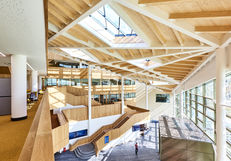The Urban Sciences Building (USB) is a building-as-a-lab (BaaL) dedicated to innovative, interdisciplinary sustainability research, and home to Newcastle University’s School of Computing. Completed in August 2017 and situated on Newcastle Helix, once the site of a colliery in the heart of Newcastle, the USB now stands as an exemplar for a lower carbon age.
Electrically led, the building features a heating system fed by heat pumps, grid-integrated energy storage, photovoltaic (PV) and PV-thermal arrays – linked to a DC micro-grid, and over 4000 digital sensors/meters to realise the BaaL concept. Data from the USB is live-streamed to the cloud by the University’s Urban Observatory for open research use, with approaching 0.5 billion data points recorded since commissioning.
BREEAM ‘Excellent’ (78.1% including an innovation credit for our energy storage test-bed), the project also goes beyond BREEAM by using a bespoke, stakeholder-led sustainability framework covering aspects of in-use sustainability including; operational energy and water reduction, demand response, and research impact.
Top 3 learnings:
1. ‘Off the shelf’ metrics can only take you so far – ask ‘what does sustainability mean to me?’
2. Make sure your project team and contractor deliver your definition of sustainability – think bespoke!
3. Involve key stakeholders (academics, building users, sustainability staff, students) from conception to completion - and beyond.
CO2t savings 2017/2018: 17% (Estimated against a notional building)
CO2t savings 2018/2019: 17% (Estimated as per 17/18)
There are many features and activities within USB that will reduce emissions in comparison to a notional ‘Building Regs minimum’ building of the same size. This saving is circa 17% in design terms and we target further savings through research activity, innovative technologies, behavioural change and good energy management.
Full year figures for low carbon technologies are not yet available (but, for example, PV savings estimated at 33,000kWh or 3,941kgCO2e), and in-use comparison against our TM54 operational energy model, procured under our bespoke sustainability framework, is yet to be completed.
CO2t savings over the life cycle of the project: TBC
We do not ignore the fact that the University, in line with much of the HE sector, is in a phase of growth. As a new building on a vacant plot, and as the space previously occupied by USB building users will be occupied by others (following refurbishment), USB represents growth in floor space (and carbon emissions) to support the academic purpose of the University.
Videos








 Except where otherwise stated, content on this site is
licensed under a Creative Commons Attribution 3.0 License.
Except where otherwise stated, content on this site is
licensed under a Creative Commons Attribution 3.0 License.
